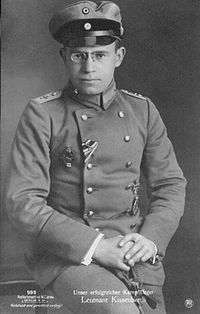- Otto Kissenberth
-
Otto Kissenberth 
Sanke postcard #595, showing Otto KissenberthBorn 26 February 1893
Landshut, BavariaDied 2 August 1919
Bavarian AlpsAllegiance German Empire Service/branch Luftstreitkräfte Years of service 1914-1918 Rank Oberleutnant Unit FA 8b, FA 9b, KEK E, Jastas 16 & 23 Awards Pour le Mérite Otto Kissenberth (26 February 1893 – 2 August 1919) was a German flying ace of World War I.
Born in Landshut, Bavaria in 1893, Kissenberth studied at Grenoble University completing an engineering degree in Munich and then working for the Gustav Otto aircraft works as a mechanical engineer.[citation needed]
With his interest in aircraft design, Kissenberth joined the German Air Force in 1914. Toward the end of the year, he completed his training as a reconnaissance pilot and was posted to FA 8b as a Vizefeldwebel. On 21 March 1915, he was wounded in action over the Vosges Mountains. When he recovered, he joined FA 9b on 8 July 1915, serving in Italy and on the Vosges front. In 1916, as a fighting pilot with KEK Einsisheim, Kissenberth was credited with his first three victories on 12 October. An Anglo-French bombing raid of some three French squadrons, 26 aircraft from the Royal Naval Air Service, and a contingent of four from the Lafayette Escadrille attacked the Mauser Rifle Works at Oberndorf am Neckar. Kissenberth blunted the assault, downing two of the invaders on his first sortie, and another on his next one. It was a feat worthy of Württemberg's Friedrich Order, Baden's Order of the Zähringer Lion, and the Bavarian Military Merit Order.[1]
Not until the summer of the following year would he score again. As a member of Jasta 16b, he downed two SPADs and flamed a balloon. On 4 August 1917, Kissenberth assumed command of Jasta 23b.[2]
One of only three German aces to wear spectacles during the war, he most often flew an Albatros D.V with yellow and white Edelweiss painted on its fuselage. After scoring more than a dozen victories with this aircraft, he scored his final victory flying a captured Sopwith Camel. Less than two weeks later, on the evening of 29 May 1918, he was seriously injured when he crashed the British fighter. Returning to duty later that year, he served as commanding officer of the Schliessheim flying school until the end of the war. In 1919, Kissenberth was killed in a climbing accident while mountaineering in the Bavarian Alps.[3]
References
Early German Aces of World War I. Greg VanWyngarden, Harry Dempsey. Osprey Publishing, 2006. ISBN 1841769975, 9781841769974.
Sources of information
- ^ Early German Aces of World War I. pp. 85–88.
- ^ http://www.theaerodrome.com/aces/germany/kissenberth.php Retrieved on 28 April 2010.
- ^ http://www.theaerodrome.com/aces/germany/kissenberth.php Retrieved on 28 April 2010.
People and aircraft Campaigns and battles Strategic bombing (German, Cuxhaven) · Bombing of cities · Fokker Scourge · Flight over Vienna · Bloody April · BattlesEntente Powers air services Australian Flying Corps · British air services (Royal Flying Corps, Royal Naval Air Service, Royal Air Force) · French Air Service · Imperial Russian Air Force · Italian Military Air Corps · United States Army Air Service · Greek air services (Army Air Service, Naval Air Service)Central Powers air services German air services (Army Air Service, Navy Air Service) · Austro-Hungarian Imperial and Royal Aviation Troops · Ottoman Air Force · Bulgarian Army Aeroplane SectionThis biographical article related to the German Air Force is a stub. You can help Wikipedia by expanding it.
